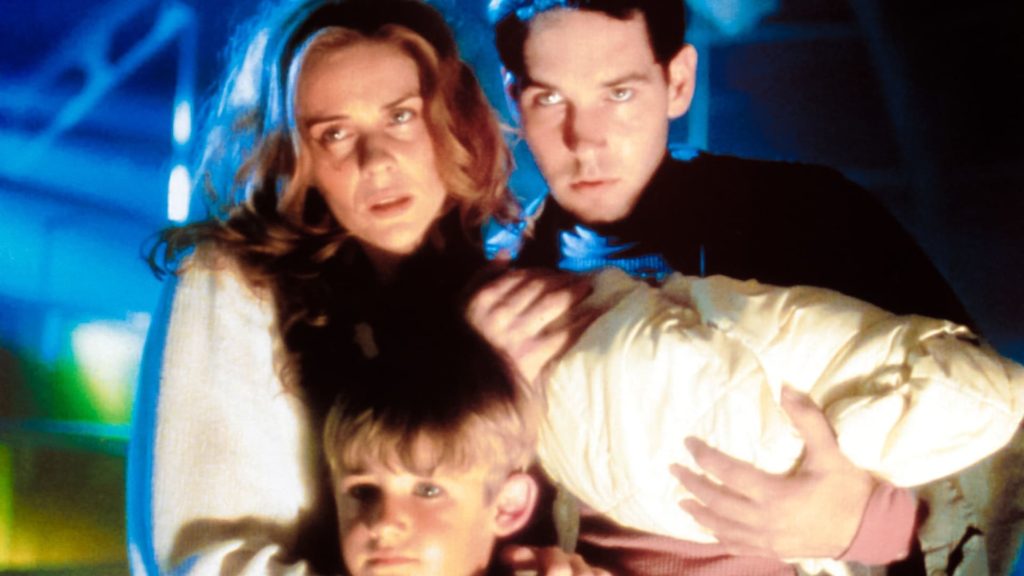And so the first Halloween timeline ends with a whimper. This is a bad, bad, bad movie. Ugly, incomprehensible, and back-breakingly self-serious, The Curse of Michael Myers is the low point thus far for the Halloween series. I watched the original cut — an 87-minute hack job after a much longer cut fared poorly with test audiences. In an astonishing feat of ingenuity and dedication (one that I can’t imagine the shitty sixth film in a slasher franchise deserved), fans recovered a workprint, reassembled the longer version, and released a bootleg clocking in at over two hours. In the years since, the bootleg was officially released as the “Producers Cut.” If The Curse of Michael Myers was even remotely good, my completionist instincts might force me to watch the extended edition and re-review the film, but I have absolutely no desire to do so. 87 minutes was tough enough to get through.
Anyways, as bad as the movie is, I get at a base level the instinct to try and unify the Halloween story into a single, comprehensive, lore-rich sendoff that ties up loose ends. This results in an attempt at a grand supernatural explanation of all the Myers murders. But slashers are very much not a genre of film that require narrative cohesion or benefit from exposition: give me jump scares, gnarly deaths, a kickass heroine, and a few moments of black comedy. That’s all I need. The Halloween series, especially, crumples under added lore: Much of the appeal of the spectacularly perfect and elegant 1978 original film is that it is so pure and simple and unburdened. No complicated mythology needed for “The Shape” — he’s just a murderous void of empathy.

The gist of The Curse of Michael Myers — so much as can be understood from the impenetrable theatrical cut — is that Myers is the victim of some curse called “Thorn,” and various characters we’ve met through the franchise to this point are connected to the curse, and now the government is getting involved (or something), but Myers wants to finish his murder spree before he’s stopped. It’s all dogshit that went in one ear and out the other.
The movie is dire from the start — this film suffers immensely from having a cheap mid-90’s ugly look and spastic editing. Filmmakers were just starting to figure out computers, and I suspect this distinct pre-Scream tenor of heightened horror drama is at least in part attributable to the old-heads using computers to amplify their worst instincts.
Then we get the biggest jump scare of the film, when Paul Rudd’s voice then face appear. Yes, Paul Rudd! You can tell he’s itching to ham up his material as a slightly creepy and horny but good-hearted Myers obsessive — who is also apparently the toddler that Laurie Strode babysat in the first film, now a young adult, because this is the kind of fan-servicey movie that brings in connections like that. Rudd restrains himself just enough to be boring on screen (and discordant to those who know him as a comedian), though admittedly still charismatic.

The film’s most promising idea is rushed through in the film’s first half: taking the toxic, curdled resentment of an unhappy suburban family and literalizing it into physical violence. There’s a spectacularly douchey dad (Bradford English) and a submissive mom (Kim Darby) and every associated hoary cliche you can guess for a domestic satire, so there’s something cathartic seeing the unhappy family drama turned into a bloodbath. (Also, the family’s last name is Strode, like Laurie, but they live in the old Myers house, which was not really explained in the theatrical cut; or if it was, it came as part of a stream of pointless exposition that did not register.) Alas, the family is killed off real quick, and this idea is ditched by the halfway point to pore deeper into the “Thorn curse” slog.
The other semi-interesting but deeply botched idea in the film is setting the climax in a weird sci-fi underground lab. It’s totally out of place from the Halloween vibe, and not in a particularly fun or playful way. Myers is wandering around the lab as if he’s an employee; I assume that is given some explanation in the Producers Cut.
Everything about the character work and plot is remarkably boring, but the real disappointment is the execution of the scares. The jump scares are so half-assed. There’s no menace to Myers’ lumbering this time around. And there’s lots of lazy tricks: for example, we get multiple POV-style shots where the surprise is that nobody’s standing where the camera had been making us think someone was. It’s the stupidest kind of fake out. (There is at least noticeably more gore and visceral violence than the past couple outings, which adds a little bit of unexpected crunch to some of the kill scenes.)
Donald Pleasence is the only returning cast member of note, and there’s something slightly elegaic about his performance as Dr. Sam Loomis. It’s a diminished role, almost stately compared to his Ahab frenzy of the previous two films, and tinted with sadness… even before we see the title card dedicating the film to his passing as it fades to black. (He died shortly before the film’s debut.) His performances were always fully invested and moderately interesting, the one unifying thread across this first Halloween timeline. We may as well call it “The Loomis Timeline” (in fact, I think I will).
I’m glad to know that the series changes directions after this, bringing Jamie Lee Curtis back and ditching most of the accrued mythology and convoluted narrative. Because if the series were to go on like this, I’m not sure I could make it much further.
- Review Series: Halloween
Is It Good?
Very Not Good (1/8)
Dan is the founder and head critic of The Goods. Follow Dan on Letterboxd. Join the Discord for updates and discussion.

